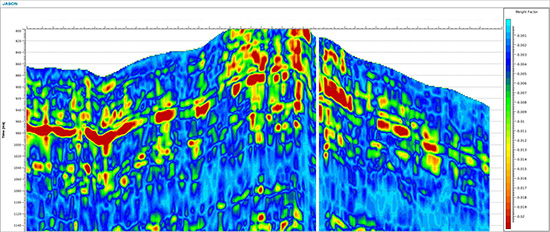Anisotropic Inversion for Better Well Placement
Paris, France | Oct 19, 2016
Generating the clearest possible models is essential in understanding reservoir complexity and placing wells in the most profitable locations. At the SEG 2016 convention in Dallas, CGG will highlight how the latest releases of its reservoir characterization solutions address these challenges in complex, unconventional reservoirs.
In shales and fractured carbonates, a proper understanding of local anisotropy is critical in designing any well program. Engineers must ensure that horizontal wells are drilled along the direction of minimum local stress to obtain the best fracturing results. The outcomes of fracturing are better predicted when there is an understanding of local rock brittleness and fracture density. In heavy oil applications, reservoir cap rock integrity, which can be inferred from azimuthal anisotropy, is important in order to avoid catastrophic effects of escaping steam during steam-assisted enhanced oil recovery. Anisotropy-corrected density estimates from inversions are also required to define the lateral and vertical extents of bitumen-laden sandstones.
By revealing essential reservoir facies and rock property information, a new Anisotropic Inversion capability within GeoSoftware’s Jason solution improves characterization of reservoirs with significant anisotropy and realizes the full value of azimuthal seismic data. The power of azimuth-based AVO inversion is used to make direct measurements of reservoir anisotropy. A dedicated analysis application provides information on critical parameters: anisotropy magnitude and direction, fracture density and rock weaknesses, all calibrated to well control.
Insufficient understanding of reservoir anisotropy can cause a number of problems. Failure to understand azimuthal variations in physical or mechanical properties derived from seismic data can lead to poor well orientation, water breakthrough along natural or induced faults, incorrect prediction of the most fractured or fracturable zones, and ultimately sub-optimum production.
Reaping the full value from anisotropic analysis methods requires proper acquisition and processing of seismic data. Wide- and full-azimuth surveys must be carefully designed and properly executed to improve coverage at all azimuths and offsets. Such surveys allow oil companies to engage in more direct azimuthal analysis compared to traditional narrow-azimuth surveys. Once the data is acquired, dedicated processing workflows preserve amplitudes and azimuths, improve the signal-to-noise ratio, and provide NMO-corrected gathers. The result is seismic data that is properly conditioned for azimuthal analysis and anisotropic inversion. With azimuthally-processed, wide-azimuth survey results, interpreters can use both vertical and horizontal transverse isotropy (VTI and HTI, respectively) models to characterize reservoirs. VTI corrections offer improved density models in regions of shale anisotropy, whereas HTI modeling can characterize azimuthal anisotropy from fractures and stress.
CGG GeoSoftware’s patented Jason Anisotropic Inversion product and workflow technology fully utilize wide-azimuth seismic data to better describe reservoirs with anisotropy. By extending the Jason VTI patent to HTI, this layer-based approach describes AVO and azimuthal effects directly on inverted reservoir properties and transforms those inverted properties to anisotropic properties that are important to engineers.
The Jason Anisotropic Inversion product helps oil companies exploit or if required, avoid existing fracture networks, better describe the extent and connectivity of the reservoir, and ultimately optimize well placement and design. To find out how these innovative techniques can help with difficult drilling and reservoir development decisions, CGG GeoSoftware is offering daily presentations and demos on demand on SEG booth #2917.
